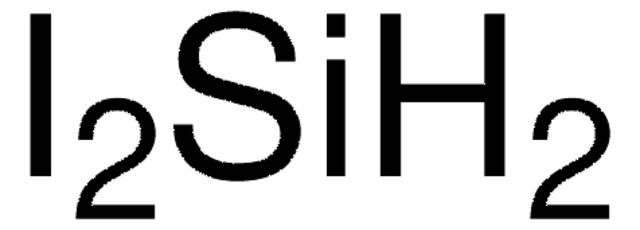440248
Dichloromethylsilane
≥97%
Synonym(s):
Methyldichlorosilane
About This Item
Recommended Products
vapor density
4 (vs air)
Quality Level
vapor pressure
6.79 psi ( 20 °C)
Assay
≥97%
form
liquid
autoignition temp.
471 °F
expl. lim.
>55 %
refractive index
n20/D 1.398 (lit.)
bp
41 °C (lit.)
mp
−93 °C (lit.)
density
1.105 g/mL at 25 °C (lit.)
storage temp.
2-8°C
SMILES string
C[SiH](Cl)Cl
InChI
1S/CH4Cl2Si/c1-4(2)3/h4H,1H3
InChI key
NWKBSEBOBPHMKL-UHFFFAOYSA-N
Looking for similar products? Visit Product Comparison Guide
General description
Application
- A General and Selective Synthesis of Methylmonochlorosilanes from Di-, Tri-, and Tetrachlorosilanes - Discusses a method for synthesizing Methylmonochlorosilanes, showing potential for varied applications in chemical synthesis (Y Naganawa et al., 2020).
- Polymerization of methylsilylenes into polymethylsilanes or polycarbosilanes after dechlorination of dichloromethylsilanes. - Investigates the polymerization of methylsilylenes, offering insights into the production of polymethylsilanes or polycarbosilanes from Dichloromethylsilanes (Y Tian et al., 2016).
- Synthesis of low viscosity of polymethylhydrosiloxane using monomer of dichloromethylsilane - Focuses on producing low-viscosity polymethylhydrosiloxane through hydrolysis-condensation of Dichloromethylsilane, significant for various industrial applications (VF Arini et al., 2022).
Packaging
Signal Word
Danger
Hazard Statements
Precautionary Statements
Hazard Classifications
Acute Tox. 3 Inhalation - Acute Tox. 3 Oral - Eye Dam. 1 - Flam. Liq. 2 - Skin Corr. 1A - Water-react 3
Supplementary Hazards
Storage Class Code
4.3 - Hazardous materials which set free flammable gases upon contact with water
WGK
WGK 1
Flash Point(F)
-18.4 °F
Flash Point(C)
-28 °C
Personal Protective Equipment
Certificates of Analysis (COA)
Search for Certificates of Analysis (COA) by entering the products Lot/Batch Number. Lot and Batch Numbers can be found on a product’s label following the words ‘Lot’ or ‘Batch’.
Already Own This Product?
Find documentation for the products that you have recently purchased in the Document Library.
Customers Also Viewed
Our team of scientists has experience in all areas of research including Life Science, Material Science, Chemical Synthesis, Chromatography, Analytical and many others.
Contact Technical Service











